#hebrew mysticism
Explore tagged Tumblr posts
Text
#Ophanim#Ezekiel's Vision#Celestial Beings#Biblical Angels#Wheels Within Wheels#All-seeing Eye#Illuminati Symbolism#Hebrew Mysticism#Divine Hierarchy#Thrones in Heaven#Book of Enoch#Throne Angels#Chariot of God#Nebuchadnezzar#Babylonian Exile#Ezekiel 1#Revelation in Old Testament#Glory of God#Cherubim#Gyroscope Wheels#Spirit of Life#2 Enoch#Wycliffe Bible#Christian Eschatology#Spiritual Realms#God's Chariot#Prophetic Visions#Divine Revelation#Christian Mysticism#Animal Faces in Prophecy
0 notes
Text

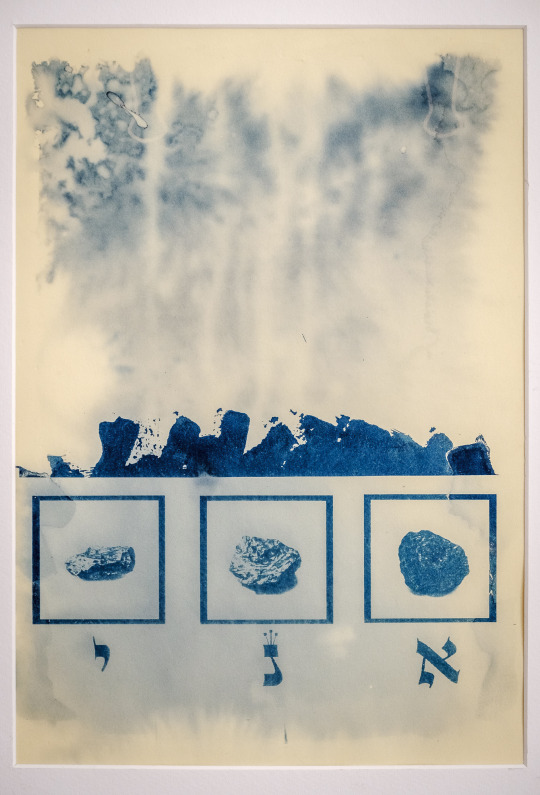


I made this print by using an old archaic photographic tecnique called cyanotype (or sun/blue print) for the phylosophical and mystical poem by Szilárd Borbély, the The Sequence of Three Secrets (A Három Titok Szekvenciája), which is a part of his series called Hasidic Sequences, where he reflects on Hasidic teachings and beliefs in literary form.
You can purchase this original and only one, signed copy through my Etsy if you like it.
Here's my english translation of the poem, below there is the hungarian original.
Taub Eizik from Kalev, a pupil of the Seer of Lublin said that there are three types of secrets in the world. One is is like this Self-Consciousness, which
that everyone carries within himself because of their previous lives. And have no idea what it is. And don't understand why hide it from others, because it is
hidden from itself too until he dies again. The second secret, is like a light hiding in the mind, nesting in the depths of the skull
until it knows the essence of speech: in the letters of writing the faint glimmer of the primordial light that has come to us from the beginning of creation
that gleams in the depths of life. When the Self begins to read a book written in human language, Finally, the third secret is that of the
one who says: I. While he sorts the stones at the beginning of the path waiting for you, already prepared the unturned stones by the entrance gate
and then reads the engraved for the greatest secret is the stone that only means the Self. And it does not say, Amen.
#poem#jumblr#mystical#phylosophy#hasidic#teachings#ezoteria#judaism#jewish#print#etsy#order#original art#cyanotype#cyanotype printing#hebrew#Ani#illsutration#illustration
176 notes
·
View notes
Photo

158 notes
·
View notes
Text
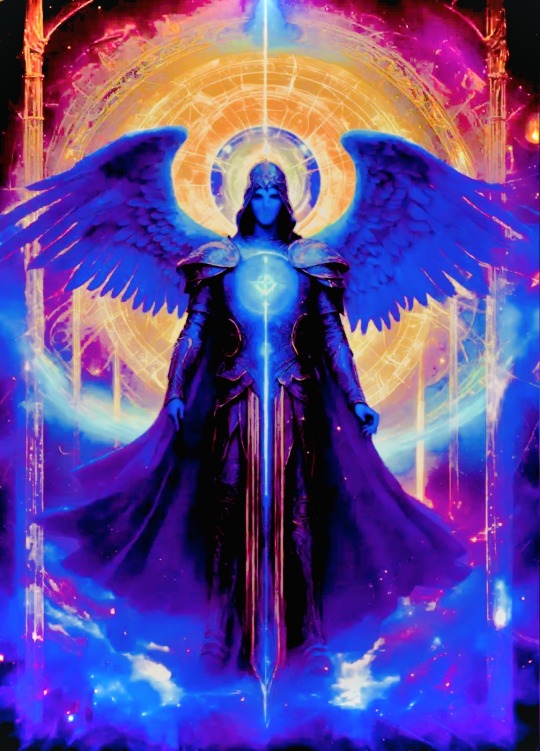
Raziel/Gallitsur
"God is my Mystery", “Secret of God” and "Keeper of All Magic”
Archangel of secrets, mysteries, mysticism and wisdom
7 notes
·
View notes
Text
John the Baptist's Wilderness Vegetarian Diet Explained - Spiritual Awakening Radio Podcast
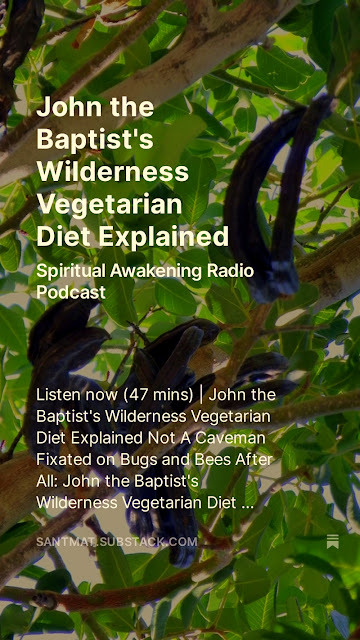
Not A Caveman Fixated on Bugs and Bees After All: John the Baptist's Wilderness Vegetarian Diet - Locust Beans Not Bugs - An Exploration of Early Christian Writings and Scholarly Texts Today on This Spiritual Awakening Radio Podcast.
Nevermind the old Sunday school notion of John the Baptist being some weird caveman dude dining on bugs! John may have a tarnished caveman reputation of eating locusts and honey out in the wild, but this is really a story about copyists mistranslating a Greek word as "locust" ('a-k-r-i-d-e-s') instead of "carob" ('e-g-k-r-i-d-e-s'). (Henry Ford: "Anyone who stops learning is old, whether at twenty or eighty. Anyone who keeps learning stays young." Albert Einstein: "Intellectual growth should commence at birth and cease only at death.")
Since my original research on this topic, a couple more early Christian apocryphal writings have come to light, have been made available in English. These add to the surprisingly large collection of vegetarian references in early Christian writings regarding the diet of John the Baptist. New Testament Apocrypha, Vol. III, by Tony Burke was published and some John the Baptist books are included. In one of the earlier volumes there was a John the Baptist text made available for the first time in English that has a vegetarian passage regarding John's diet in the wilderness. Included in the third volume are, The Birth of Holy John the Forerunner, and, The Decapitation of John the Forerunner, both containing plant-based passages about John's diet consisting of "locusts from the tree" (in the Middle east called "the Saint John's Tree", and "Carob Tree") and "wild honey", also "an abundance of bread and wild honey dripping from a rock". Clearly there was an understanding in early Christianity that this was referring to locust beans (carob pods), not insects. Carob pods do look a bit like locusts hanging from tree branches, hence the name. Locust beans can be ground up and used to make a kind of Middle eastern carob flour flat bread. There's a "cakes dipped in honey" reference in the Gospel of the Ebionites. The wild "honey" was not from bees but sticky desert fruit of some kind. So, as you'll hear being documented during this pod...cast, there are all these plant-based references to John's diet coming from many different sources, and scholars have noticed and discussed these: "Probably the most interesting of the changes from the familiar New Testament accounts of Jesus comes in the Gospel of the Ebionites description of John the Baptist, who, evidently, like his successor Jesus, maintained a strictly vegetarian cuisine." (Professor Bart Ehrman, Lost Christianities: The Battles for Scripture and the Faiths We Never Knew) "His [John the Baptist's] food was wild honey that tasted like manna, like a cake cooked in olive oil." (The Other Gospels, Accounts of Jesus from Outside the New Testament, by Bart Ehrman)
John the Baptist was a prophet with large number of followers in Israel and Transjordan regions. After his passing, several of his successors headed what became various rival Nasoraean (Nazorean) sects, one of those being Jesus and the Jesus movement. "Again Jesus said to his disciples: Truly I say to you, among all those born of women none has arisen greater than John the Baptizer." (Matthew 11:11, George Howard's translation of Shem-Tob's Hebrew Gospel of Matthew, described as "the oldest extant Hebrew version of the Gospel of Matthew")
John the Baptist's Wilderness Vegetarian Diet Explained - Spiritual Awakening Radio Podcast - Listen and/or Direct MP3 Download @:
https://traffic.libsyn.com/spiritualawakeningradio/John_the_Baptists_Wilderness_Vegetarian_Diet_Explained.mp3
@ the Podcast Website With Buttons That Go To All the Popular Podcast APPS - Wherever You Follow Podcasts:
https://SpiritualAwakeningRadio.libsyn.com/john-the-baptists-wilderness-vegetarian-diet-explained
@ Apple Podcasts:
https://podcasts.apple.com/us/podcast/john-the-baptists-wilderness-vegetarian-diet-explained/id1477577384?i=1000635517078
@ Spotify:
https://open.spotify.com/episode/0lMU46P0Tm9uugwN7IRgC5
@ Audible:
https://www.amazon.com/Spiritual-Awakening-Radio/dp/B08K561DZJ
@ Google Podcasts:
https://podcasts.google.com/search/spiritual%20awakening%20radio
& @ Wherever You Subscribe and Follow Podcasts - At Your Favorite Podcast APP Just Do a Search for "Spiritual Awakening Radio" - (Apple Podcasts, Spotify, Google Podcasts, Amazon, Audible, PodBean, Podcast APP, Overcast, Jio Saavan, iHeart Radio, Podcast Addict, CastBox, etc...):
https://linktr.ee/SpiritualAwakeningRadio
May the Blessings Be,
James Bean
Spiritual Awakening Radio Podcasts
Sant Mat Satsang Podcasts
Sant Mat Radhasoami
A Satsang Without Walls
https://www.SpiritualAwakeningRadio.com
#prayer of thanksgiving#go vegan#vegan thanksgiving#john the baptist#new testament apocrypha#vegan#veg#veganism#vegan christian#christian mysticism#christian mystics#vegetarian christians#early christianity#john the baptizer#gospel of matthew#gospel of the ebionites#gospel of the hebrews#hebrew gospel of matthew#jesus#vegan jesus#happy vegan thanksgiving#spiritual awakening radio podcasts
13 notes
·
View notes
Text
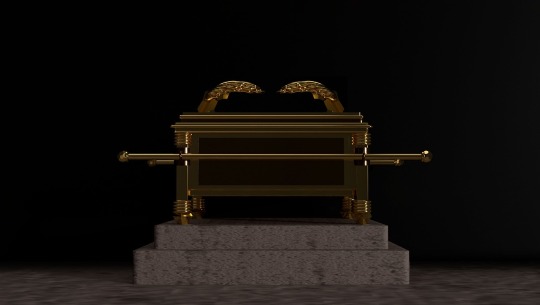
Topic: Kabbalah: The Legacy of the Initiates
Time: Oct 9, 2023 07:00 PM Central Time (US and Canada)
Spiritual initiates from every religion have existed, conveying their teachings through diverse scriptures, allegories, and symbols. The Jewish mystics were no different. However, their knowledge was codified in such a way as to provide accessibility and insight for those who were trained to read, interpret, and understand with an awakened consciousness. This lecture builds on [Kabbalah: The Doctrine of Soul and Spirit](https://chicagognosis.org/lectures/kabbalah-the-doctrine-of-soul-and-spirit), describing how five elements of Medieval Judaism can inform our understanding of initiatic life, specifically through Aggadah (narrative tradition), Halakah (Jewish law), Piyyut (liturgical prayer), Merkavah mysticism (the science for creating the soul), and The Sefer Yetzirah (a profound scripture of magical, initiatic import).
To freely register, visit:
#gnosticism#gnosis#spirituality#awakening#consciousness#gnostic#spiritual#chicago gnosis#samael aun weor#kabbalah#gnostic kabbalah#qabala#qabalah#cabala#judaism#jewish#jewish mysticism#hebrew#mysticism#mystical#mystical experiences#meditation#religion#religious art#spiritual journey#spiritual enlightenment#spiritual growth#spiritual disciplines#spiritual development#spiritual knowledge
6 notes
·
View notes
Text
"The Tao that can be told is not the eternal Tao. The name that can be named is not the eternal Name." --Tao Te Ching
Compare with 10th century Jewish Philosopher Maimonides in his ' The Guide for the Perplexed ' :
" G-d's existence is absolute...
Consequently it is a false assumption to hold that He has any positive attribute; for He does not possess existence in addition to His essence ;
it therefore cannot be said that The One may be described as an attribute.".
#comparative religoin#philosophy#taoism#god#religion#judaism#moses#maimonides#guide for the perplexed#hebrew#mysticism#tao te ching#chinese history#chinese philosophy#sages#moshe ben maimon#rambam
5 notes
·
View notes
Text
Ancient Egyptian Cosmology
Welcome back to my bible study! I know I keep going in and coming out, but biblical literature is not a one and done kind of experience.

Genesis 1:1-2
“In the beginning, God created the skies and the land. Now, the land was wild and waste (tohu va-vohu) and darkness was over the face of the deep (tehom) but the breath of Elohim was hovering over the face of the waters (hamayim)
We’ve got a few problems here. "Tohu va-vohu" means chaos and emptiness—wild, messy, and uninhabited. Then there's the issue of constant darkness. And finally, those deep, primordial waters—the abyss.
I’d say it’s trouble in paradise, but we’re not even at paradise yet. These are the problems that need solving before paradise can come!
But there’s a story happening here. In the beginning, God created the skies and the land—great! But the land is tohu va-vohu—uh-oh. And darkness covers the deep abyss? That feels pretty hopeless…
But then, the breath—the Ruakh of Elohim—was moving over the waters.
There’s two words for waters here. One is them, which is the underworld, abysmal waters. Remember in Jonah’s poem, the deep, pit of the underworld, the water that is under the land, so it has a negative connotation to it.
But the waters that God is hovering above here is different. The word used is hamayim. You can drink those waters and water your garden with them. It’s as if once the spirit of God shows up the tehom, the threatening waters, are neutralized to become something God can work with.
*Notice a parallel between hamayim and shamayim. Mayim is the waters. Some people debate that the root is Mayim and you add a sh before it, which does connect the concept of the waters above, the heavens–the shamayim above. But then some people dispute that. I’ll go into this further another time. It’s a long debate*
Alright, back to the verses at hand.
So what exactly is happening here? We have the initial statement, the first sentence. Then immediately we go into this problematic environment of darkness and abyss. So the question is, what’s the relationship between verse 1 and verse 2? I think you can get to an answer in 2 different directions.
The first is to get into tune into the ancient debate of rivaling cosmologies. Another is to look at the other cosmologies from Israel’s neighbors. So let’s dive into this rabbit hole before progressing any further.
“The framers of creation in the Bible inherited a treasure trove of venerable traditions from their cultural neighbors. Instead of creating their accounts ex nihilo, the composers of Scripture developed their traditions in dialogue with some of the great religious traditions of the surrounding cultures, particularly those originating from Mesopotamia and Egypt, as well as those of their more immediate Canaanite neighbors.”
Brown, William (2010). Seven Pillars Of Creation: The Bible, Science, and the Ecology of Wonder. Oxford University Press.
He is talking about the biblical authors behind all the creation accounts. Not just Genesis 1, but Psalms 104, Psalms 8, Psalms 74 and many more. His words have generated a reaction and nervousness from many people, and I’m sure you can understand why. It kind of sounds like he’s saying it isn’t God’s word and they’re just borrowing from their neighbors. So, remember back to our previous studies–am I just borrowing from modern cosmology when I talked about the solar system my grandpa taught me about? Technically, it’s my culture–a shared cultural environment. That’s exactly the same thing here. Jesus spoke Aramaic. It’s a shared cultural environment. The biblical authors are making claims about the God of Israel–worldview claims through the medium of their concepts of creation and cosmology.
A key point to remember is that the Bible’s creation narratives are not in dialogue with modern scientific ideas about world origins. Rather, they are in dialogue with Egyptian, Babylonian, and Canaanite cosmologies. And within that dialogue, Genesis 1-3 shows many similarities with other ancient Near Eastern cosmologies, along with many key differences. But before we get into this, we need to answer this question: What is an ancient Near Eastern cosmology?
As we’ve looked at previously, a cosmology is an account of the origins of the universe as humans experience it. So an ancient Near Eastern cosmology is an account of the origins of the universe according to those living in the ancient Near East, including the biblical authors. How are ancient cosmologies different from modern cosmologies? The primary purpose of ancient cosmology narratives is not to describe the physical-material processes by which the universe came into being in language or categories that make sense to a modern audience.
Modern Egyptology began after Napoleon overtook Egypt in the early 1800s, opening it to European colonial powers. Jean-Francois Champollion, the first famous Egyptologist, deciphered the Rosetta Stone and unlocked the Egyptian hieroglyphic system.
Key texts containing Egyptian cosmologies are:
The Pyramids Texts (Old Kingdom, 2600-2100 B.C.E.)
The Coffin Texts (1900s-1600s B.C.E.)
The Book of the Dead (1500s-1000s B.C.E.)
“The waters speak I am the Waters, unique, without second. Atum speaks That is where I evolved, on the great occasion of my floating that happened to me. I (Atum the creator) am the one who once evolved— Circlet, who is in his egg. I am the one who began therein, (in) the Waters. See, the Flood is subtracted from me: see, I am the remainder. I made my body evolve through my own effectiveness. I am the one who made me. I built myself as I wished, according to my heart.”
Hallo, William W. (1997). “The Coffin Texts 714.” The Context of Scripture: Canonical Compositions from the Biblical World, Vol. 1. Brill. 6-7.
The account goes on to describe the generation of eight other deities out of Atum’s own body and these different deities are all different elements of the cosmos. One thing stands out to me; it solves the chicken and egg thing.
How convient to say “I created myself” *mic drop*
Anyways, the deity is self-generating, but what is the deity? The waters. So, in other words, the deity is not a being who addresses the waters as something other than the deity itself. The waters, the elements of the cosmos are the deity.
The cosmos is self-generating becausee it is the God. So this fits into the category of the world views of pantheism, namely that all reality is divine. The rock, the tree, the wave, you and me.
Think of it..like an egg floating around in water. But the waters and the deity are this metaphorical egg out of which emerges his own self. Not the “the flood is subtracted from me”.
It seems the first half of the poetry is trying to create a clear identity between Atum and the waters. The waters are the deity, but then once Atum emerges as a self-defined being, the waters can now be talked about as an other that are subtracted. Out of those waters, Atum later brings into existence all other sub deities who are less powerful. So, I guess it makes sense poetically.
This is an Egyptian cosmology. Just think about ancient Egypt – where is this civilization located? Centered around the Nile River, that goes out in the Mediterranean Sea. You can see it from a satellite. It’s a green strip in the rest of Northern Africa. Everything is built on that river.
This river flows out into a great sea. This is a culture whose existence is nurtured by the waters The waters are the source of life. The geography gives us a handle to understand why the waters would be given the central role of the most primal, divine force. This helps illuminate Genesis 1 by imagining an Israelite sitting down and having a conversation here.
We agree that waters are the most fundamental, but here’s the thing–the waters don’t just give life, they also destroy life. There is a great metaphysical question that they’re not quite getting at here, which is who made the waters? The point is there’s common ground. When we want to talk about non creation or the preexistent pre creation state the waters are in at this beginning point.
There’s a scholar named Bernard Bath who pulled together a really great summary of “In ancient creation imagery in the ancient near east” whole chapter on Egypt. There’s also a Hebrew Bible scholar who’s made his whole career of archiving and cataloging ancient Egyptian Canaanite and Babylonian art. His name is Othmar Keele.
Let’s discuss Bernard Bath a bit further. Here is an Egyptian Heliopolitan cosmology as summarized by him in his book In the Beginning: Essays on Creation Motifs in the Ancient Near East and the Bible
The primeval creator is called Atum, who is equated with Nun, the unordered watery substance from which all things emerged. This state of non-creation was a chaotic watery condition devoid of elements or structures necessary for life, but it possessed the potential for development. Atum began to evolve and differentiate himself from his watery incubation onto a primeval mound of dirt, which is symbolized as the prototypical pyramid, and from there he began a process of self-development or “creation.” He generated the rest of the Ennea (a cluster of eight other deities) by self-impregnation: He swallows his own reproductive fluids and generates Shu (goddess of air) and Tefnut (goddess of moisture), from whom come Nut (goddess of the sky) and Geb (god of earth.) Atum took his role as the “eye” of all creation, the sun god Re, and they all worked together in a form of order called Ma’at, the eternal divine order that undergirds all creation.
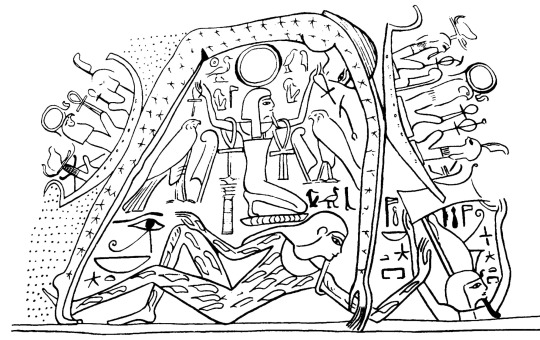
Above is an image archived by Othmar Keel, titled Symbolism of the Biblical World: Ancient Near Eastern Iconography and the Book of Psalms. Eisenbraums.
Nut is the sky goddess who is the sky-dome full of stars. Geb is the land god, and Shu, the god of air, kneels on Geb and supports Nut. The sun god Re travels in the waters above the Nut, riding his boat across the sky (upper left) and descending into the realm of darkness and death to the waters under the land.
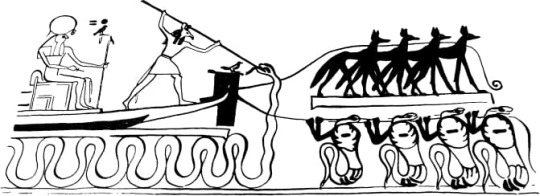
Another entry from the same title
The sun god Re is pulled through the underworld sea at night. The god Seth spears and defeats the death god Apophis (a snake), while the boat is pulled by subjugated night demons (jackals and snakes).
What is illuminating here is the primal waters as the beginning point of creation and the this multi-tiered cosmos that really resembles what we saw in Genesis 1, but not exactly identical. Thees are all deities that you need to get their favor and offer them sacrifices and pray to them, so that they’ll uphold and not collapse. So, HUGE difference, but also structurally similar.
Until next time.
#studyblr#christian faith#christian blog#christianity#religion#esoteric#religionblr#actually autistic#esoterist#christian mysticism#christian study#study motivation#bible study#study blog#studying#ancient egypt#cosmology#ancient cosmology#hebrew#egyptian#egypt#Atum#Nut#gods and goddesses#gods#goddesses#Bible#Christianity#Jesus#jesusisyahweh
1 note
·
View note
Text
Rare Kabbalah Books - Very Good Condition
Very Good Condition








#rarebooks#kabbalah#vintagebooks#metaphor#symbology#judaism#qabalah#mysticism#esoteric#booksforsale#hebrew#alefbet#treeoflife#merkava#merkaba#religion#hekhalot#angels#YHVH#ceremonialmagick#magick#theosophical#occult#spirituality#christianity#gnosticism#hermeticism#metaphysical
0 notes
Note
do you have any favourite historical overviews or introductions to christian mysticism that you could please recommend? ilysm habibti
works marked with * are what i would recommend for absolute beginners on the topic.
introductory works:
thomas merton, a course in christian mysticism: thirteen sessions ith the famous trappist monk*
william a. richards, sacred knowledge: psychadelics and religious experiences (on the practical applications of entheogenic, or drug-induced, mysticism)
william james, the varieties of religious experience, especially lectures 16 and 17*
bernard mcginn, the essentials of christian mysticism (arguably the best starter anthology of christian mystical writing)*
mircea eliade, the sacred and the profane
robert s. ellwood, mysticism and religion*
ed. amy hollywood, the cambridge companion to christian mysticism*
steven t. katz (ed.), mysticism and sacred scripture, especially the first chapter, "mysticism and the interpretation of sacred scripture," and the second chapter, "mysticism and scriptural justification"
primary works:
anon, the cloud of unknowing and other works (a.c. sperings translation for penguin is probably the most accessible)
teresa of avila, the life of saint tereesa of avila by herself
simone weil, waiting for god*
julian of norwich, revelations of divine love*
john of the cross, spiritual canticle (i recommend this to newcomers to christian mysticism over dark night of the soul, which is extremely dense and often devastating)
meister eckhart's sermons- though the book i'm linking is essentially a primer to german mystics
hildegard of bingen's scivias; but this selected works is a good place to start
margery kempe, the book of margery kempe by herself*
bernard of clairvaux’s sermons on song of songs*
marguerite porete, the mirror of simple souls
rebecca jackson, gifts of power*
catherine of siena, dialog
secondary works:
evelyn underhill, mysticism: a study in the nature and development of spiritual consciousness
evelyn underhill, practical mysticism*
caroline walker bynum, jesus as mother: studies in the spirituality of the high middle ages
caroline walker bynum, wonderful blood: theology and practice in late medieval northern germany and beyond
caroline walker bynum, holy feast and holy fast: the religious significance of food to medieval women*
grace m. jantzen, "eros and the abyss: reading medieval mystics in postmodernity"
grace m. jantzen, becoming divine: towards a feminist philosophy of religion
denys turner, the darkness of god: negativity in christian mysticism
jeffrey kripal, roads of excess palaces of wisdom: eroticism and reflexivity in the study of mysticism (+a lecture by him)
marsha aileen hewitt, freud on religion*
sarah clairmont, "she'll eat him up she loves him so" (one of my all time favourite papers)
also, the bible: which is probably the most vital of works on christian mysticism, as nothing you read about mysticism will not be influenced by it. i personally have recently been reading a combination of the JPS tanakh and the jewish annotated new testament, but the new revised standard edition (+apocrypha) is generally standard. if you are reading the bible academically for learning about mysticism, or have absolutely no background with reading the bible, i recommend the following books specifically:
the torah (genesis*, exodus*, leviticus, numbers, deuteronomy*)
the major prophets isaiah* and ezekiel*
the minor prophets (all of which constitute my favourite part of the bible) joel*, jonah*, micah*, malachai*
psalms*, job*, the song of songs*
the gospels, especially mark* and john (mark is the oldest and most "jewish," john is the most recent and most "gentile"; matthew and luke are probably more familiar than both)
the epistles: james*, jude*, 1-3 john, 1-2 peter, hebrews
the revelation to john
everything i've recommended here you can find online (internet archive or annasarchive); i've also tried to keep it extremely general and limited to work that i've personally read and vetted. if there's specific aspects or topics you're interested in (ie women's mysticism, medieval mysticism, mysticism and eating, freud and mysticism, commentaries on specific mystics etc) just drop me an ask! very honoured you've asked me beloved <3
377 notes
·
View notes
Text
Magic in Ancient Greece: An Introduction
I have seen some people claim that magic or witchcraft did not exist in Ancient Greece. This is not the case. So, I thought I'd take the opportunity to introduce you all to the strange and wonderful world of Ancient Greek magic!
First, what do we mean by "magic"? Radcliffe Edmonds, one of the leading scholars on Ancient Greek magic, defines "magic" as "non-normative ritual behavior." In short, what makes something magic, and not just normal religion, is that people in a given culture think it's weird. The word "magic" itself refers to the magi, Zoroastrian priests — the Ancient Greeks thought they did magic because to them, Zoroastrianism was foreign and weird. They also thought that Ancient Egyptians could do magic for the same reason — what the Greeks thought was spooky magic was just normal religion in Egypt. Within their own culture, magic was basically heteropraxic religion. Magic was not considered hubristic, at least not inherently.
There are multiple Ancient Greek words that refer to magic. The word μάγος, magos, itself means "magician" or "charlatan." There's also γοητεία, goetia, usually translated as "sorcery." The word most often translated as "witchcraft" is φαρμακεία, pharmakeia, the use of drugs or herbs to transform or influence people. This is what Medea and Circe do.
One of our best sources on Ancient Greek magic is the Greek Magical Papyri, or PGM, a set of magical texts from Hellenistic Egypt. When I first learned about it, I thought it was too good to be true, but here it is: uncorrupted ancient pagan magic! Essentially, the PGM is one of the oldest known grimoires, and the ancestor of the entire Western magical tradition. The papyri contain spells and rituals for almost every purpose: curses, love spells, divination, dream oracles, summoning daimones, necromancy, even full mystical rites. Most of them include invocations to various gods, which are heavily syncretic. Helios/Apollo (treated interchangeably) is invoked the most often. Aphrodite appears pretty often, too. Hekate-Artemis-Selene-Persephone (conflated with a whole bunch of other chthonic goddesses, including Ereshkigal) has her own set of spells. You'll even find the names of Egyptian gods and Hebrew angels in there.
One of the most common features in PGM spells is voces magicae or barbarous names, nonsense words that are supposed to be the secret names of the gods, which give you the authority to call them up. They act almost like a written form of glossolalia. Most are supposed to be spoken or chanted aloud. Some sound like actual names, or are well-known magical epithets like ABRASAX. Some are just strings of Greek vowels. Some of them are palindromic; there's lots of spells that use the "abracadabra" disappearing-letter-triangle format. There's also charakteres, apparently-meaningless magical symbols, the distant ancestor of modern sigils.
Another major source for Ancient Greek magic are defixiones or katadesmoi, curse tablets. They're little lead leafs called lamellae, which are inscribed with curses and then deposited in wells, graves, and other chthonic places. Thousands of them have been found.

Here's the text of a curse tablet that invokes Hekate and Hermes Kthonios (copied from Curse Tablets and Binding Spells from the Ancient World by John G. Gager):
Hermes Khthonios and Hekate Khthonia Let Pherenikos be bound before Hermes Khthonios and Hekate Khthonia. I bind Pherenikos’ [girl] Galene to Hermes Khthonios and to Hekate Khthonia I bind [her]. And just as this lead is worthless and cold, so let that man and his property be worthless and cold, and those who are with him who have spoken and counseled concerning me. Let Thersilochos, Oinophilos, Philotios, and any other supporter of Pherenikos be bound before Hermes Khthonios and Hekate Khthonia. Also Pherenikos’ soul and mind and tongue and plans and the things that he is doing and the things that he is planning concerning me. May everything be contrary for him and for those counseling and acting with…
Another curse tablet, which invokes Hekate to punish thieves, includes a drawing of her and charakteres. This is how she's depicted:

From Curse Tablets and Binding Spells in the Ancient World by John G. Gager
It's supposed to be a woman with three heads and six raised arms, but to me it looks like Cthulhu, which is honestly appropriate.
There was a very fine line between love spells and curses in Ancient Greece. Some love spells in the PGM call upon the spirits of the dead and chthonic gods to torture a poor girl until she submits to the magician. Just as many defixiones attempt to forcefully bind a lover. But there's another, gentler kind of love spell described by Theocritus in Idylls, in which a witch named Simaetha invokes the Moon and Hekate and uses an iynx wheel to make a man love her.
If you want to know how to apply all of this in modern practice, I'm still working that one out. I've found the PGM very hard to adapt, because a lot of its requirements are dangerous or impractical. Many of its spells require gross ingredients worthy of the Scottish play, or plants that scholars can't identify, or procedures that I don't plan on attempting. And if you haven't noticed by now, most of them fly in the face of modern magical ethics. (Don't let anyone tell you that the gods will punish you for doing baneful magic, because that's clearly bullshit.) On the other hand, Crowley adapted his Bornless Ritual almost word-for-word from PGM V. 96—172. So far, the best resource I've found on modernizing Ancient Greek magic is The Hekataeon by Jack Grayle. Its material is clearly historically-inspired, but still doable, and spiritually relevant. I really recommend getting it if you have the means, especially if you have an interest in Hekate specifically. I'm happy to have it as a model for how to adapt ancient magic for myself in the future. To me, it strikes the perfect balance between historically-informed and witchy, which is right where I want to be.
If you can't access that one, here's some other books I recommend:
Drawing Down the Moon: Magic in the Ancient Greco-Roman World by Radcliffe G. Edmonds III: An introduction to Ancient Greek magic, both scholarly and accessible. It covers the definitions and contexts of magic, curses, love spells, divination, theurgy, philosophy, basically everything you need to know.
The Greek Magical Papyri in Translation by Hans Dieter Betz: The definitive English edition of the PGM. A must if you plan to study ancient magic in-depth, especially as a practitioner.
Curse Tablets and Binding Spells in the Ancient World by John G. Gager: An English edition of the texts of many curse tablets.
Magic, Witchcraft, and Ghosts in the Greek and Roman Worlds by Daniel Ogden: a sourcebook of ancient literature concerning magic.
The Golden Ass by Apuleius: A Roman novel about a man who is turned into a donkey by a witch. A very entertaining story, also our source for "Cupid and Psyche" and one of the best sources on the Mysteries of Isis that we have.
Ancient Magic: A Practitioners Guide to the Supernatural in Ancient Greece and Rome by Philip Matyszak: A simple and straightforward introduction to Ancient Greek magic, less scholarly but very easy to follow and directed at practitioners.
#occultism#occult#ancient greece#ancient magic#folk magic#pgm#greek magical papyri#curse tablets#helpol#hellenic polytheism#hellenic paganism#hellenism#magic#occult history#history#ancient greek history#book recommendations#hecate#hekate
171 notes
·
View notes
Text
Scams, Hoaxes, Conspiracy Theories, & Cults Everyone Should Know About
Jilly Juice: Jillian Mai Thi Epperly claimed drinking sixteen cups of her super salty cabbage concoction each day could regrow missing limbs and cure everything from cancer to homosexuality. In reality, overdosing on so much salt caused followers a host of health issues that Epperley dismissed as "healing symptoms."
Nonhuman Body Hoax: Jaime Maussan attempted to pass off mummified human remains as nonhuman beings to the Mexican government. (This isn't even Maussan's first hoax, by the way. He has a history.)
Love Has Won: Amy Carlson, a woman who'd walked out on her own children, started a New Age cult in which she presented herself as "Mother God," the creator of the universe. She claimed to be in contact with dead celebrities and alien beings, and taught a conspiratorial worldview. As her health declined, she attempted to treat herself with colloidal silver and alcohol, and her behavior became increasingly abusive. When she finally died, her followers sincerely believed she would return to life and kept her body in a sleeping bag. (She did not return to life.)
Seed Faith Offerings: Reverend Gene Ewing came up with the perfect get-rich-quick scheme to prey on desperate Christian believers: tell believers that if they "sowed seed" by giving money to him, God would bless them with even more money in the future. He made millions of dollars from these donations, while most of his followers never saw the miraculous returns they were promised.
William Walker Atkinson: In the early 20th century, William Walker Atkinson wrote around one hundred books, many of which he wrote under various pseudonyms. Some of these pseudonyms included alleged Hindu mystics. That's right - this guy was practicing literary brownface to sell his mystical ideas.
The LDS Church: In the 19th century, a man named Joseph Smith claimed that an angel had told him where to dig up a set of golden plates that were supposedly written by ancient Hebrews who'd come to North America. Smith even had eleven close associates who vouched for the plates' existence. Yet the script they were allegedly written in bore no relation to actual ancient scripts of the Near East, and the the names the locations in the books he "translated" were very obviously derived from placenames he would have been familiar with. (For example, Oneida/Onidah.) Oh, and actual archaeology and DNA studies have discredited pretty much everything from this guy's weird racist narrative.
Fake Cancer, Fake Cure: Wellness entrepreneur Belle Gibson claimed that she'd cured her brain cancer with natural remedies. Gibson never actually had cancer in the first place.
Medbeds: Back in 2020, QAnons and QAnon-adjacent people started circulating claims that a new form of healing technology was about to become available to the public within the next several months or so. Depending on who you asked, Donald Trump, Elon Musk, and even the Galactic Federation of Light were involved. The time of their supposed unveiling came and went, and what do you know, there are still no functioning medbeds used in actual medicine.
COVID Vaccine Zombies: Conspiracy theorists have been claiming the government practices high-tech mind control for ages now. One recent iteration of this is a conspiracy theory claiming that people who'd received COVID vaccinations would have malicious DNA code activated by 5G on October 4, 2023, turn into zombies, and riot. The time came and went, and no zombie outbreak happened.
Ms.Scribe: In the early 2000s, a Harry Potter fan known as "msscribe" or "Ms.Scribe" faked her own harassment through a number of sockpuppets, with the apparent goal of becoming friends with some Harry Potter fandom bigwigs. She manipulated the fandom for a few years until the deception was finally uncovered.
301 notes
·
View notes
Text
it’s pretty ironic how much anti-zionists quote Emma Lazarus
“None of us are free until all of us are free!” Like yes girl that quote is generally accredited to Emma Lazarus, who was a Zionist and ALSO was speaking about Jewish refugees fleeing antisemitic violence in Russia
Anyways Emma Lazarus is my favorite poet so here’s some facts about her while I wait in an airport for my flight to take off
She was descended from Sephardic Jews who fled the inquisition and settled in the Americas in the 1600s
Most of her poems revolved around Jewish themes
She wrote the famous poem at the base of the Statue of Liberty, “The New Colossus”
She volunteered with the Hebrew Immigrant Aid Society helping Jewish refugees from Russia get settled in the US
She was a Zionist over a decade before the modern Zionist movement was founded, and advocated for the creation of a Jewish homeland in Eretz Yisrael and wrote essays against antisemitism
And here is a passage from my favorite Emma Lazarus poem, “In Exile”
Strange faces theirs, wherethrough the Orient sun / Gleams from the eyes and glows athwart the skin. / Grave lines of studious thought and purpose run / From curl-crowned forehead to dark-bearded chin. / And over all the seal is stamped thereon/ Of anguish branded by a world of sin, / In fire and blood through ages on their name, / Their seal of glory and the Gentiles' shame.
Freedom to love the law that Moses brought,/ To sing the songs of David, and to think / The thoughts Gabirol to Spinoza taught, / Freedom to dig the common earth, to drink / The universal air—for this they sought / Refuge o'er wave and continent, to link / Egypt with Texas in their mystic chain, / And truth's perpetual lamp forbid to wane.
If you want to read more here is an article I can recommend you: https://www.womenshistory.org/education-resources/biographies/emma-lazarus
#jumblr#jewish#chana talks#judaism#israel#am yisrael chai#i stand with israel#antisemitism#anti zionism#antizionism is antisemitism#emma lazarus#the new colossus#yes this post was motivated by Chappell roan
397 notes
·
View notes
Text
My Lost Books of the Bible article @ Medium!
dead sea scrolls nag hammadi library new testament apocrypha gospels gnostic gospels books of enoch ebionites gospel of the hebrews gospel of thomas coptic apocrypha
christian mysticism
#christian mysticism#lost books of the bible#nag hammadi library#gospel of thomas#gospel of the hebrews#ebionites#new testament apocrypha#sayings of jesus#book of enoch#apocrypha#gnostic gospels
18 notes
·
View notes
Note
Is there a particular significance in Judaism to the number 18 or multiples of it? I work at a financial institution and recently worked on a deposit of a large number of checks a girl had received for her bat mitzvah. (Nothing problematic about the checks themselves, there's just some extra review that goes in when it's money gifted to a minor, and especially a whole mittful of paper checks all at once.) I noticed a lot of the check amounts were multiples of 18 - 54, 72, 108, 252, etc. So I wondered, is that a number that's significant in relation to b'nei mitzvah? I couldn't find anything by googling, but online search engines seem to be weird when numbers are involved.
Rating: Jewish
Short answer: Yes, 18 and its multiples are considered good luck in Jewish culture!
Longer answer: Gematria is the ancient practice of assigning numerical values to letters, and has been used for millennia by Jews for all kinds of counting, including calendars, Biblical chapters and verses, and so forth. This also means that any given Hebrew word has a numerical value, and much has been made mystically of connections between words that have the same value as other words, and what that might mean. 18 is the numerical value of the Hebrew word "חַי" which means "life" and is considered a particularly lucky amount for monetary gifts, implicitly wishing the receiver a long life.
401 notes
·
View notes
Note
lilith is jewish and open ok. like moses. lilith is a synchretic figure already diffused between innumerable groups separated by time and space, connected by names and stories. it really makes me feel lonely unsafe and uncomfortable to be a jewish lilith worshipper here, like devil worship is somehow wrong now. ! demon worship is not wrong. Will it be antisemitic next to disagree with mosaic law? Will polytheism be antisemitic? Sodomy? idk its been worrying me more of late like its paralleling the societal move backwards w transphobia and sexphobia and conflation of not-antisemitism with real antisemitism like people who say any/all critique of israel makes u an antisemite!!(its doesnt)(neither does nonjews interacting with lilith) but with how the vibes are now!!!This is all going a sad direction :( ardent philosemitism can turn antisemitic too!!!
As a white gentile, I feel absolutely disgusted with people who share my status doing that to Jews. I hope they all fuck off and leave you all alone, its not hard to learn that you can't have something. I may think Lilith is cool, but that's it, I don't practice or worship with her cause she's not mine to do so. I seriously hope y'all get a reprieve from these people, having to fight just so people leave your religion alone sounds so very tiring, my condolences. None of you deserve what's happening to you
I'm not Jewish though a proud ally. But I hope my Jewish followers see this.
#i can agree that it would be appropriation to make medieval apotropaic lilith wards but that is not how lilith worshippers even act#its just a reinterpretation of the same allegory#its just humans interacting with art#people getting weirddd reactionary christian to kabbalah and lilith on here#please begin the crusades against Neon genesis evangelion and pokemon for appropriation first#BEHEMOTH LEVIATHAN ZIZ#GROUDON KYOGRE RAYQUAZA#GOLEM GOLEM REGIS REGIGIGAS GOLETTE GOLURK#LILITH AND REI AND KAWORU#every single angel with a hebrew name in neon genesis#please go after this before innocuous internet mystics 🌬️💋#omg or will pop paganism be the next occult antisemitism!!! Apollo shake the 8 ball baybee#Supernatural UR ON THIN FCKN ICE 😂😂😂LUCIFER TOO#idk i personally believe religion is allowed to be fun
16 notes
·
View notes